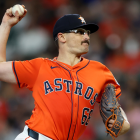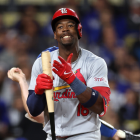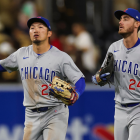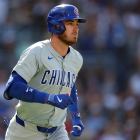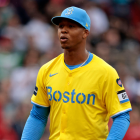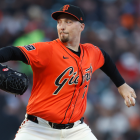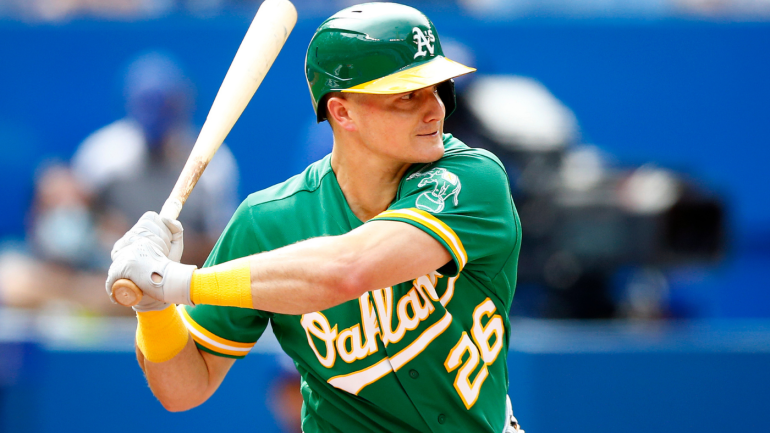
The Toronto Blue Jays acquired third baseman Matt Chapman from the Oakland Athletics on Wednesday in exchange for a group of four prospects: right-hander Gunnar Hoglund, infielder Kevin Smith, and lefties Zach Logue and Kirby Sneed.
The Blue Jays had been connected recently to free-agent hitters like Freddie Freeman and Kyle Schwarber. Freeman hasn't yet signed, but Schwarber reportedly reached an agreement on Wednesday morning with the Philadelphia Phillies. Chapman, then, may end up being Toronto's big offseason addition to its lineup. He has the potential to be an impactful one, though he comes with significant risk.
From Oakland's perspective, Chapman is the second Matt the Athletics have traded this week, joining new Atlanta Braves first baseman Matt Olson. Factor in right-handed starter Chris Bassitt, who was dealt to the New York Mets last weekend, and the Athletics' rebuild is well underway. This likely won't be the final time this month the Athletics are featured in one of our "Trade Grade" pieces.
As the name implies, these pieces are where we rush to judgment by assessing freshly made deals. Sure, our analysis might look stupid in a few years' time, but we're here to inform and entertain. With that out of the way, let's rehash the specifics of this trade:
Blue Jays receive
3B Matt Chapman
Athletics receive
- RHP Gunnar Hoglund
- INF Kevin Smith
- LHP Zach Logue
- LHP Kirby Sneed
Now, onto the grading.
Blue Jays grade: B
There's no denying that Chapman is a phenomenal talent. He's one of the best defensive third basemen in the league, and after more than 2,000 trips to the plate he boasts a career 120 OPS+. He's a three-time Gold Glove Award winner already, and he's twice received votes for the Most Valuable Player Award. He'll turn 29 in April, but he has two more years of team control remaining, meaning the Blue Jays will likely have him under employment for the duration of his statistical prime.
Still, it must be written that there's more risk to Chapman's game than you might think.
Over the past two seasons, Chapman's strikeout rate has ballooned to an uncomfortable degree. Whereas he entered the pandemic era with a career 23.9 percent strikeout rate, he's fanned in more than 33 percent of his plate appearances the past two seasons. Chapman has always been prone to popping the ball up, running a career infield fly rate of 17 percent, or five percentage points higher than average.
That combination, strikeouts and pop-ups, now eats up such a great share of Chapman's plate appearances that he'll be hard pressed to post a decent average. This isn't 2002; everyone knows batting average is not the end-all, be-all. It is, nevertheless, the foundation on which on-base and slugging percentages are built upon. You're unlikely to reach base 40 percent of the time or post a .500 slugging percentage if you're hitting around .215, the way Chapman has the last two years.
It doesn't do much to calm anyone's nerves that Chapman: A) underwent hip surgery in 2020 that ended his season early; and B) saw his ball-tracking metrics crater last year. His average exit velocity dropped nearly four miles per hour (though it was still above the league-average mark), and his percentage of batted balls that were measured at 95 mph or better dipped from 53 percent to 42 percent. His average flyball distance was also the worst of his career, at 319 feet. (His career average, even with last season taken into account, is 326 feet.)
There's no way of knowing how much of Chapman's recent issues are due to his hip, and there's no way of knowing if he'll be able to return to his old form. That's the point, right? For as good as he was prior to 2020 -- and he looked like one of the best players in the game -- there's a lot of uncertainty about where he goes from here. In 10 years' time, will these last two seasons stand out as unfortunately timed outliers, or will they represent the tell-tale beginning of a premature decline? It's to be seen.
Mind you, the Blue Jays should still feel comfortable with this trade. Their roster is good enough that they don't need prime Chapman in order to compete for an American League East crown. Moreover, his defense at a premium position gives him a higher floor than the average player, and his power should play up in a more friendly offensive environment. (To wit, Statcast's calculations suggest he would've homered an additional five times last year had he played his games at Rogers Center.) There's real upside here, in other words; there's just more downside than you might think.
CBS Sports' Fantasy Baseball Today podcast broke down the Chapman trade and more on an emergency episode Wednesday. Listen below:
Athletics grade: B
This package might feel light given Chapman's name value and track record as an impact-level player, but the aforementioned concern with his risk profile left the industry doubtful the A's would get a massive return. What they did get, in general terms, is a promising young starter and three players who are big-league ready -- one of whom should step into Chapman's spot, and another who fits their ballpark well. It's not the sexiest return, but it's all right considering the larger context.
Hoglund, 22, is the most important part of the package for the Athletics. He was Toronto's first-round pick last summer, No. 19 overall by way of Ole Miss, and he would've gone higher had he not required Tommy John surgery during the spring. When he was healthy, he established himself as a polished right-hander with good command and a spin-heavy arsenal, including a fastball that can touch into the mid-90s and a cutter-like slider. Provided Hoglund makes a full recovery, he has the potential to develop into at least a middle-of-the-rotation starter. There's a fair chance for even more based on his precision and his innate pitch attributes.
Smith, 25, made his big-league debut last season and saw action at three positions over the course of 18 games. (To be fair, 14 of those came at third base.) He didn't perform well at the plate, hitting for a .382 OPS and striking out 11 times in 32 at-bats. Smith has altered his swing in recent years, starting and keeping his hands around his helmet until it's time to launch. That change seemingly helped him recover from a rough 2019, as he batted .285/.370/.561 with 21 home runs in 94 Triple-A games. He remains prone to striking out, to the extent that he's unlikely to ever run a high average. Smith does have above-average pop, however, and his ability to play either position on the left side of the infield grants him a wider berth offensively. Oakland has Nick Allen, one of the top defensive shortstops in the minors, nearing his own debut; Smith, then, might want to plan on making the hot corner his own.
Logue, 25, popped up on the prospect radar last season after he improved his velocity and amassed a 3.67 ERA and a 5.33 strikeout-to-walk ratio in 125 innings split across Double- and Triple-A. He still doesn't throw hard, but there's a difference between sitting in the low-90s and working in the high-80s. Logue's best pitch is his changeup and he creates deception with a lower arm slot. In a vacuum, he projects as a back-end starter. The A's, thanks in part to playing in a cavernous ballpark, have received better-than-expected mileage from other finesse flyball lefties in the past, including Cole Irvin last season. Logue ought to get his shot at outperforming his scouting report soon, perhaps even out of the gate as a member of the A's remade rotation.
Snead, 27, reached the majors last season and posted a 2.35 ERA and a 3.50 strikeout-to-walk ratio in seven appearances. He's a pure reliever, a crossfiring slider-sinker lefty with a low release point. That slider features above-average sweep and he's shown a willingness to throw it against batters of either hand. Alas, Snead has struggled with right-handers for most of his professional career, suggesting he might top out as a specialist. At minimum, he's a readymade low-cost relief option for an Athletics team that continues to stripmine its roster of veteran pieces.















